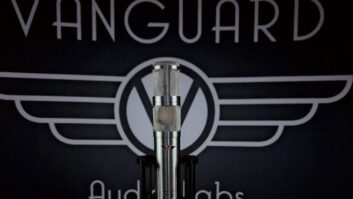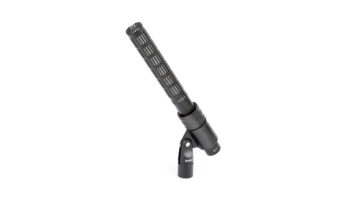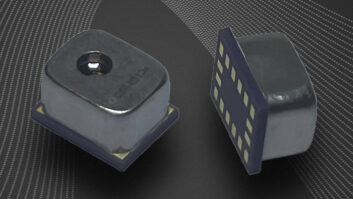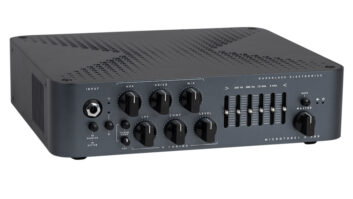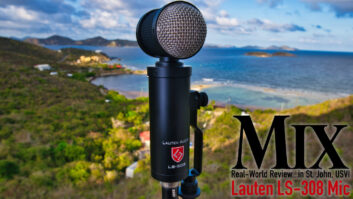Alesis has successfully made its mark in signal processors, drum machines, sequencers, synthesizers, tape recorders (and what a mark that is) and studio monitors, as well as introduced several mixers. It was inevitable that the company would some day tackle microphones. In 1998, Alesis acquired the Groove Tubes line of electronics, securing the talents of their designer, Aspen Pittman, and founding a new division, GT Electronics.
The first offering from GT, the AM Series of microphones, consists of four models of large-diaphragm condensers situated right in the middle of one of the hottest and most competitive regions of the microphone market: the mid-priced condenser. The AM61 ($999) and 62 ($1,299) are built around a mil-spec Groove Tubes GT5840M tube, a subminiature pentode wired as a triode to yield softer overload characteristics. The GT5840M was also chosen for its suitability in implementing a circuit with low microphonics. The AM61 and AM62 employ a nickel-core output transformer from Cinemag, a small manufacturer of high-quality transformers. The AM51 ($549) and AM52 ($699) are a Class A FET design and use more standard ferrite core transformers.
Each design features a flagship multipattern model (the AM52 and 62) and a less expensive cardioid-only model (the AM51 and 61). The 52 and 62 have two-sided diaphragms to allow multiple patterns (cardioid, bidirectional, omni and, on the 62, supercardioid), while the single-pattern 51 and 61 employ single-sided diaphragms.
All of the AM Series models feature a brass capsule with a diameter of more than an inch, a 3-micron gold-evaporated-on-mylar diaphragm, and a gold-plated center element, which works like the old “whizzer cone” speaker designs to enhance high-frequency and transient response by creating a very small acoustical resonance circuit. Each mic also offers a 10dB pad and 75Hz highpass filter with a 12dB/octave slope. It is nice to find the pad and filter even on the 51/61; many competitive mics do not include those. The 52 and 62 also have pattern selector switches, and the 62 has an additional cardioid/supercardioid switch.
The FET mics require 48V phantom power to operate, while the tube models come with a power supply and special cable. (The cable runs from the mic to the power supply; a standard XLR connector on the power supply connects to the rest of the world.)
The AM Series mics come in heavy-duty, hard cases and include slipcover “socks” to protect the bodies when not in use or when left set up on stands overnight. The tube mic cases are particularly nice, including spots for carrying the power supply and cable, along with a shock-mount. (Swivel mounts are standard with all AM models.) The mounts have a full range of motion, which is very useful in obtaining proper placement with large microphones. All in all, the accessories are luxurious for microphones in this price range.
THE VOCAL SESSIONSFor my review, GT supplied a pair of AM62s and a pair of 52s. The AM Series is heavily touted for vocal applications, but I did try them on instruments, too.
I first tested the AM Series on a touring singing group of ten Tibetan nuns. The group was recorded at two San Francisco studios: Outpost and D’Cuckoo Soundware Farms, home of producer Candice Pacheco. At the first session, at Outpost, the nuns were sitting on the floor in two rows facing each other. A number of mics were used, including the AM52s and 62s, AKG 414, Neumann U67, and AKG 3000. The mics were placed between the rows of nuns, faced alternately such that each nun had a mic facing her.
Outpost engineer David Nelson said his first impression of the AM52 was that it was “crispy,” which he feared would make the tracks sound “artificial.” However, as he soloed the various mics to adjust for the best blend, he looked up several times when he liked the sound of a soloed mic and found it was the 52. Over the course of the session, Nelson became increasingly enamored of both the 52 and the 62, also citing their off-axis rejection, which was vital in such a setup.
Pacheco, too, liked the GT mics, using them again at the session in her studio, which she also engineered. To allow the greatest flexibility in mixing, she wanted the nuns miked individually. That session started with the same mic setup as at Outpost, but a series of solo and duo prayers was also recorded with the 52 set to the bidirectional pattern, a nun on either side of it.
“The nuns voices were really a challenge,” Pacheco said. “They all had a very pronounced resonance at 4 kHz, since they barely move their mouths and mostly sing through their noses. Another challenge in the recording is that they not only chanted but played instruments, which bled through on their vocal tracks.
“Both the GT mics handled these problems better than the other microphones we used. There was noticeably less bleedthrough, especially on AM62s, than the other microphones. The AM62 handled the 4kHz resonance much better and had a more warm sound while still retaining the crispness. The AM52 also had very nice response, and for the price I think they are good microphones if you are on a budget. I was really impressed with the AM62 and am planning on purchasing one.”
I set up my own comparison test for vocal recording, pitting the 52 and 62 against an AKG 414B/ULS, which is in roughly the same price class, and a Neumann TLM103, which costs three to four times as much. The mics were fed through an Earthworks Lab102 mic preamp, converted to 48kHz/24-bit digital by a Panasonic DA7 mixer, and recorded at the full 24-bit resolution by a Mark of the Unicorn 2408 running AudioDesk software. Playback was monitored through Genelec 1031A loudspeakers.
I recorded myself and singer Dian Langlois so that I had both male and female voices to compare. The most important performance aspect of vocal microphones is not usually accurate, transparent pickup, but a good match between the character of the mic and the sound of the particular voice. Thus, it is no slight to say that the frequency responses of the AM52 and 62 are not flat.
Not surprisingly, there was greater clarity and evenness in the TLM103 than any of the other three, but the differences between the 414 and the GT mics were mostly in their character. The sound of the AM62 had some high-end roll-off and low-end boost, which is typical of many tube microphones I’ve heard. This tended to nicely soften my voice, which has a somewhat harsh nasal quality that is exacerbated by most vocal mics. Dian’s voice sounded great through the 62 when she was belting it out, though I did detect a bit of splatter in the high-mids when she hit strong notes.
In contrast, the AM52 has a prominent rising response, which sounded wonderful and breathy when Dian sang a soft ballad but produced a good deal of sibilance on my voice. In fact, I found that I had to sing off-axis to the 52 to avoid the headphone feed singeing my ears. By way of comparison, the 414 landed squarely between the 52 and 62, with a flatter high and low end, but a bit of boxiness in the mids. My little test served mostly to reinforce the notion that few vocal mics are suited to every need; the 52 and 62 worked great with the right voice match and poorly when the strongest characteristics of the voice played into a weakness of the mic. The 414 came out as the best all-around, but the trade-off was that it was never able to attain the pristine cleanliness of the TLM103, the rich warmth of the AM62, or the airiness of the AM52.After doing the bulk of the comparison with all of the mics set to cardioid, I tried some of the other patterns, starting with supercardioid. The 52 does not have hypercardioid or supercardioid patterns, but the 62 offers a supercardioid pattern. The off-axis response of the 62 in this pattern fell off more smoothly than some hyper- or supercardioids I’ve tried. This means that there was less tonal change when Dian or I moved around while we sang, but the rejection was not as tight as some other mics.
When I experimented with the bidirectional setting, I was surprised to find that the rear pickup of both the 52 and 62 sounded noticeably different than the front, with less low frequencies and a bit more high-mids. I did not find anything as noticeable between the front and rear of the 414 or TLM103 when set to bidirectional pickup. Although this could be beneficial if you are using the pattern to pick up ambience from the rear, it would be problematic if you were using it to record two vocalists singing together while standing on opposite sides of the mic.
I also tried the GT mics for speech, reading from a little-known book by Robert Louis Stevenson. In this application, the 62 was the clear winner, as the 52 created a sibilance problem. Again, a different voice could produce another result. The 62, however, produced a rich, articulate sound that was quite satisfying.
RECORDING INSTRUMENTSHaving put the mics through their vocal paces, I set them to work on instruments. The results were exactly what I predicted from the outcome of the vocal tests. For drum overheads, the 62s worked well with jazz playing and yielded a sort of rolled-off, British sound for rock. The 52s were a little too aggressive for me as drum overheads; both they and the 62 presented some distortion on the cymbals (which I hear from almost all mics I use for drum overheads except DPA/B&K and Earthworks). However, that same bite proved advantageous when I put the 52 on snare. I also liked the 52 quite a bit on dumbek, as I like to hear the sound of my hands on the head very clearly articulated-the 52’s rising high end accomplished that nicely.
At composer/keyboardist Peter Drescher’s Twittering Machine studio, I tried both GT mics on his 1927 Steinway baby grand piano, feeding the mics through a Studio Technologies preamp into a Panasonic SV-3800 DAT. The 52’s high end was too strident for Drescher’s mellow piano, but the 62 was lush and full, producing the most pleasing sound Drescher has gotten recording that instrument. In this trial, the mics were placed inside the piano, but the same brightness that made the 52 unsuitable in this situation could make it ideal for a mid- to far-field miking approach, providing compensation for the air absorption of high frequencies.
The 52 proved to be a better performer when we recorded some of Drescher’s bells and ethnic percussion; however, close-miking loud instruments like agogos sometimes resulted in a bit of “splatter” (sounding like slight high-mid- to high-frequency distortion) in the high end.
The most interesting instrumental test, however, was when I put the GT mics on my vibraphone and compared them to a pair of Earthworks ZX30 small-diaphragm condensers, which are squarely in the same price class. Although I have yet to find anything that tops the ZX30 for this sort of acoustic recording, the AM52 did better than I expected in producing a sound that was bright but did not overly accentuate the transient of the mallet hitting the bar. The 62, predictably, produced a softer, mellower tone, which would be great for ballads. However, neither produced the pristine clarity and pinpoint imaging of the ZX30.
The GT Electronics AM Series microphones are solid all-around performers and a very good value. As with most Alesis products, they are excellent for their intended applications and serviceable for a number of others. The AM52 is quite bright and seemed to work best when not very tight on the source, while the AM62 had exceptional warmth but less “air” in the very high frequencies.
It is important to have a variety of microphones in one’s cabinet, even if only for voices, but that quickly becomes an expensive proposition. The GT AM Series mics provide a means of broadening the mic selection to match a given vocalist or ensemble without breaking the bank. At these prices, one could easily end up buying one of each.
Alesis Studio Electronics, 1633 26th St., Santa Monica, CA 90404; 800/5-ALESIS; fax 310/255-3401; www.alesis.com.


